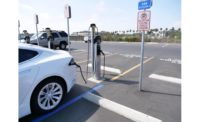Electric cars and trucks are the signature of the green movement, but they may also become a symbol of economic recovery for the construction industry. Even if the recently reported disappointments with electric cars are true, such as maximum distances between recharges of only 100 miles and top driving speeds of only 60 to 70 mph, imagine theneed for the infrastructure to support our electric cars and the stimulating effects of creating it.

SHORT
Imagine just one part of our interstate highway system: Interstate 80, from New York to San Francisco (via Omaha, my hometown), is about 2,900 miles. A minimum of 290 recharging stations would be needed on this highway. These stations would not be like our current rest stops with short-term parking, many of which are now being closed due to budget constraints. A station would have to be a little village because of all that’s needed for recharging the cars.
The electric power required to recharge the cars will require new powerplants (and if they’re going to be green, they should be nuclear). They’ll also need transmission lines, substations and recharging stations. Power companies and their contractors will appreciate all this. In high-traffic areas, the recharging stations would have to accomodate 10,000-plus vehicles, although 2,000 vehicles is more likely for lower-traffic areas.
Here’s where things can get complicated. If the vehicles use batteries that can be swapped out, there must be work bays for cars, trucks, buses, etc. If a battery swap takes 15 minutes per vehicle, then one bay can only accommodate four vehicles per hour.
On the low-traffic portions of the interstate, this means there must be 500 bays for the minimum turnaround time. If a recharge takes 60 minutes per vehicle, there would need to be more than 2,000 bays or recharging stations. Imagine how many would be required on the high-traffic areas!
These estimates are for each of the 290 recharging stations on the 2,900 miles from New York to San Francisco, not the entire interstate system of 46,900 miles, which would require a large number of employees, tooling and buildings for all-weather operations. It is unlikely any of these stations would be self-service because of the dangers of electrical shock.
So there will be many opportunities for new jobs and much training needed. Just this part of the interstate system would create 435,000 battery changing/charging jobs: 290 stations x 500 bays x one person per bay x three shifts, or 435,000. There could be many more if you count support staff—again, job creation.
An entire network of infrastructure will be needed to support these facilities and the people who operate them. The smaller recharging stations could easily require 300 to 500 acres of land just to handle the traffic flows. Attorneys will be kept busy in eminent domain proceedings—more job creation.
So far this only takes into account the service side of being green. What about the user side? Take a typical family of four on the trip from New York to California. Instead of stopping for 10 minutes every three to four hours so the fidgeting kids can go to the bathrooms and everyone can rest and refresh, a family would be able to stop every hour with a guaranteed stop time of 15 to 60 minutes. The green way of life consumes time.
For safety reasons, no one will want to stay inside an electrically powered vehicle while it’s being serviced, so they will go into a restaurant or picnic on the grounds. The green life doesn’t stressfully hurry across the country.
By some accounts, travel on the interstate highway system is about one-third of all miles driven in the U.S., so you can extrapolate the 2,900 miles here (6% of the system) to all the roads and highways.
You can make your own evaluations and comparisons between the costs of gas and electric-powered vehicles. The way I see it, a staggering array of resources will be needed to develop and support electric vehicles. Why not use fuel cells? Why not remain with hydrocarbon-based power for vehicles and convert all fossil-fired powerplants to nuclear fuel? Let’s not go down that road. Electric cars will breed much construction and an entire new support industry that is green in more ways than one.




Post a comment to this article
Report Abusive Comment